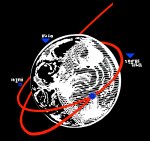
World Generation Plugin for Fuzion
Step 3: Physical Characteristics
ConversionsMass
Diameter
Density
Orbit
|
Step 3a: World Type
First, determine the type of world that should be created. Roll 3d6 and consult the following table:
|
In some cases, the GM may wish to select a world of the appropriate type, if appropriate (for example, if the campaign calls for a garden world, then the GM can choose to place a garden world in the bio zone, rather than rely on the luck of the dice).
The different world types are described below:
- Rock Ball:
- Rock balls are airless worlds.
- Ice Ball:
- Gas Giant:
- Gas giants orbit stars in the outerpart of their star systems. Gas giants are huge: the smallest are at least 10 times the mass of Earth, and the largest, the mass of 800 Earths. Gas giants are made of hydrogen, helium, methane and ammonia. Below the immensely deep atmosphere, the pressure turns the world's gases into liquid.
- Greenhouse:
- Glacier:
- Pre-Garden:
- Garden:
- Post-Garden:
- Desert:
- Failed Core:
- Asteroid Belt:
optional rule — unusual worlds
Step 3b: Diameter
For gas giants and other planets, determine the diameter as follows:
|
This diameter is measured in "Earths". To convert to kilometers, multiply by 12,800 km.
Step 3c: Density
First determine the componsition of the planet:
|
|
Next, roll 3d6, and consult the following table to find the density:
|
The density on this table is measured in "Earths" -- thus, the Earth has a density of 1.0
Step 3d: Gravity
The gravity on a planet can be determined as follows:
Gravity = Diameter * Density
Step 3e: Mass
The mass of a planet can be determined as follows:
Mass = Diameter3 * Density
Step 3f: Axial Tilt
| ||||||||||||||||||
Step 3g: Albedo

Copyright © 1999 by B.C. Holmes. Last updated November 6th, 1999.
Fuzion copyright © the Fuzion Group, 1997. All rights are reserved.
Star Hero and Hero Games are registered
trademarks of Hero Games. All rights reserved.
Back to the Empire main page.